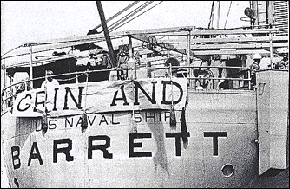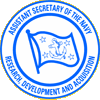 |
Military Sealift Command Overview |
|||||||||
|
||||||||||
|
|
Mission 
MSC's mission is to support our nation by delivering supplies and conducting specialized missions across the world's oceans. Vision MSC's vision is to be the leader in innovative and cost-effective maritime solutions. Strategic Priorities
We Value
Mission Areas Military Sealift Command is organized around five mission areas: Click here to view the 2012 Ships of MSC poster. MSC History During World War II, four separate government agencies controlled sea transportation. In 1949, the Military Sea Transportation Service became the single managing agency for the Department of Defense's ocean transportation needs. The command assumed responsibility for providing sealift and ocean transportation for all military services as well as for other government agencies.
Only nine months after its creation, MSTS responded to the challenge of the Korean War. On July 6, 1950, only 11 days after the initial invasion of South Korea by communist North Korean troops, MSTS transported the 24th Infantry Division and its equipment from Japan to Pusan, South Korea, for duty. During the Vietnam War, MSTS was renamed Military Sealift Command. Between 1965 and 1969, MSC transported nearly 54 million tons of combat equipment and supplies and nearly 8 million tons of fuel to Vietnam. MSC ships also transported troops to Vietnam. The Vietnam era marked the last use of MSC troop ships. Now, U.S. troops are primarily transported to theater by air. Through the 1970s and 1980s, MSC provided the Department of Defense with ocean transportation in support of U.S. deterrent efforts during the Cold War years. During the first Persian Gulf War's operations Desert Shield Desert Storm, MSC distinguished itself as the largest source of defense transportation of any nation involved. MSC ships delivered more than 12 million tons of wheeled and tracked vehicles, helicopters, ammunition, dry cargo, fuel and other supplies and equipment during the war. At the height of the war, MSC managed more than 230 government-owned and chartered ships. Since Sept. 11, 2001, MSC ships have played a vital and continuing role in the global war on terrorism. As of July 2008, MSC ships had delivered more than 16 billion gallons of fuel and had moved more than 110 million square feet of combat equipment and supplies to U.S. and coalition forces engaged in conflicts in Iraq and Afghanistan. In addition, MSC, the Navy and several non-governmental organizations have treated hundreds of thousands of patients in hospital ship deployments around the globe. Command Relationships Military Sealift Command reports through three distinct and separate chains of command:
MSC Chain of Command Photos:
Workforce MSC has a workforce of more than 9,000 people worldwide, about 80 percent of whom serve at sea. More than half of MSC's workforce is made up of civil service mariners who are federal employees. The remainder includes commercial mariners, civil service personnel ashore and active-duty and reserve military members. 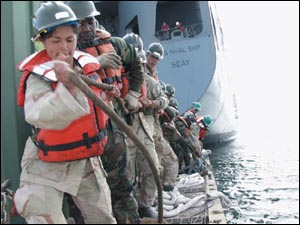
All MSC ships, unlike other U.S. Navy ships, are crewed by civilians, and some ships also have small military departments assigned to carry out communication and supply functions. Transition to War 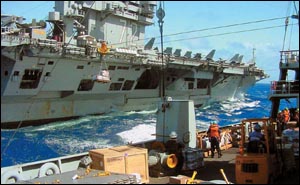
The transition from peace to war calls for a steady progression of increased levels of sealift ships and personnel to meet contingency requirements. The progression begins with prepositioning sealift. MSC's prepositioning ships are loaded with combat equipment for U.S. Army, Marine Corps, Air Force and Navy, as well as fuel for the Defense Logistics Agency. The ships are stationed in strategic areas around the world, close to potential contingency areas. In wartime, prepositioning ships are usually the first ships to respond. In wartime and during other contingencies, the Sealift force can expand dramatically to move the massive amounts of heavy armored combat equipment and other war-fighter supplies from U.S. bases to the theater of operation. MSC first looks to the commercial market to charter suitable U.S.- flagged tonnage. If more tonnage is needed, foreign-flagged ships may be used. MSC may also activate government-owned surge sealift ships, normally kept in reduced operating status. In the event of a full mobilization, more than 1,000 ships and 30,000 people would be employed in sealift missions ashore and afloat. 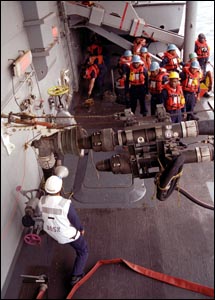
Navy-Maritime Relationship The Voluntary Intermodal Sealift Agreement, or VISA, a partnership between the U.S. government and the maritime industry, was introduced in the mid-1990s to provide joint planning and assured access to commercial shipping at pre-agreed rates during a national emergency. The agreement makes it possible for the U.S. Department of Defense to use the ships and shore-based transportation systems of ocean shipping companies in time of war. In return, the companies receive a subsidy from the federal government or are awarded peacetime defense cargo movement contracts. Thus, the companies and their assets become an integral part of military contingency planning. Navy Reserves MSC has access to nearly 900 selected reservists in MSC reserve units across the US. When mobilized, these reservists quickly take charge of establishing MSC port offices to assist with sealift operations wherever needed. For more information, go to the Navy Reserves page. Funding 
MSC's worldwide operations are financed through two working capital funds. The Navy Working Capital Fund is used by MSC to support Navy fleet commanders and other Department of Defense entities. The Transportation Working Capital Fund is used to support sealift services. Working capital funds are reimbursed by direct appropriations or by funds transferred into the working capital fund by various MSC customers. MSC receives no direct funding appropriations to support command operations; rather, MSC customers transfer funding for any service they request from MSC into the appropriate working capital fund, and MSC draws funds from the fund to pay for command operations. Unlike private industry that budgets to make a profit, working capital funds budget to break even. MSC has an annual operating budget of approximately $3 billion. Looking Ahead As the United States continues to draw down the size of its land-based military presence overseas, sealift will be an enduring mission. Our military's readiness and rapid response capabilities will depend increasingly on maintaining a presence "Forward…From the Sea." Military Sealift Command, with its wide array of ocean transportation resources and its highly trained personnel, performs vital missions around the clock and around the globe. MSC delivers! |
|||||||||||||||||||||||||||||||||||||||||||||
| Privacy Policy | Accessibility | Advanced Search | Site Index | Help | FOIA | IG Hotline |
CIVMAR support: 1-800-793-5784 • Marine Employment Opportunities: 1-877-JOBS-MSC (562-7672) • Email: webmaster@msc.navy.mil

